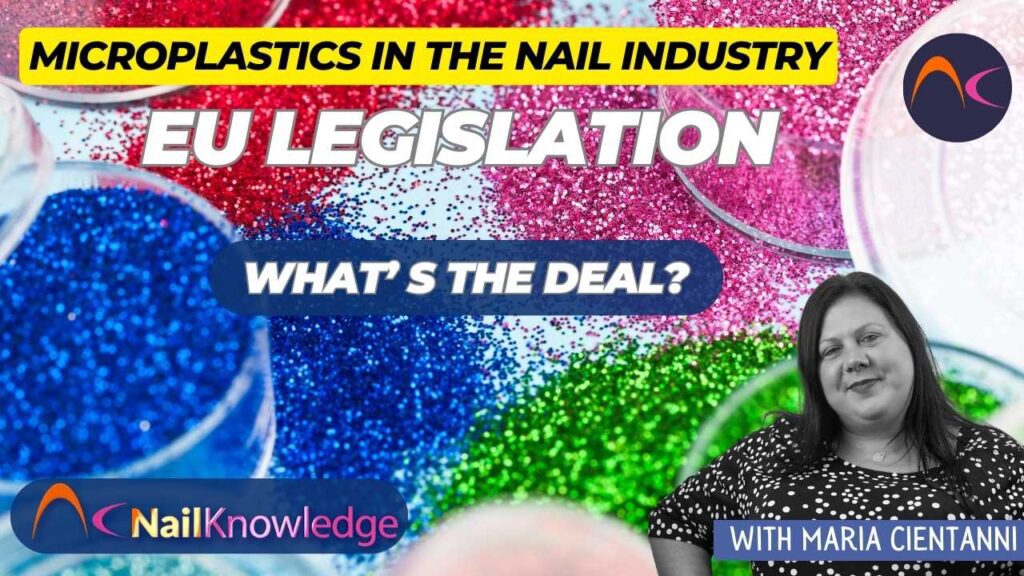We are dedicated to pioneering knowledge in the Nail Industry, emphasising factual and scientific content. Our commitment lies in contributing to environmental conservation and continuously researching methods to present information that illuminates a safe and shimmering world.
EU Legislation Update: New Restrictions on Microplastics Sales
We would like to give you this ‘News Flash’ information regarding new legislation and to assist you in understanding the ‘jargon’. You may have seen that there is going to be a change in EU law regarding the sale of microplastics from the 15th October, 2023. This new regulation is to restrict the uncontrolled release of microplastics into the environment. Microplastics is a very broad definition but it covers glitter & microbeads (exfoliation) for example.
Based on the latest information, we understand that the sale of glitters that are contained within formulations which are used for on the skin body modifications/enhancements, bath bombs, personal care, hair, make-up, tattoos etc. all fall under the new legislation restrictions immediately from this date. It is considered that these products can easily enter into the environment in an uncontrolled manner both during application and/or on removal.
Nail Cosmetic Glitters Exempt from New Restrictions
Cosmetic glitters that are solely used within the application of nail products (pre-made mixtures, encasing of glitter within a product or glitters added into nail products by nail professionals) or has any other intended use within a solid nail formulation will be unaffected for the next 12 years! So, there is no need to panic, nor the need to result in plain lifeless manicures! Phew!
Eco-Friendly Glitter: A Sustainable Shift in the Beauty Industry
In 2019, an eco-friendly alternative to traditional plastic-based glitter emerged in the market. This innovation uses natural and plant-derived materials, ensuring it biodegrades into harmless substances in the environment. Such sustainable options are available in various shades, providing a responsible choice for those concerned about the environment.
Why Nail Products Have Distinctive Legislation Regarding Microplastics
- Products used at ‘industrial sites’ (nail salons) are not freely releasing microplastics during use (nail technicians capture glitter within a moulding product).
- The nail industry works in reverse to the beauty industry. We trap/encase/encapsulate within a solid formula thus preventing the release of loose glitter particles.
- ‘The regulation specifies a transitional period of 12 years for nail products until a ban on sale or use comes into force.’
Best Practices for Nail Professionals to Minimize Microplastics Emissions
To prevent unnecessary microplastics emissions, we as nail professionals can elevate our procedures and take the following steps –
- Always firmly pat and press glitter into place using a brush
- Do not submerge fingers into jars/pots
- Do not use a large ‘duster’ brush to apply glitter
- Top coat must be used to encase the glitter finish and any loose glitter used
- Should any loose glitter remain on the nail after application, make sure all traces are removed before hands are washed.
- At the end of the day, those working with glitter should thoroughly shake off their clothes before washing
- All generated microplastic waste should be swept/vacuumed, put into appropriate waste container, and be collected by an authorised waste collection service. Never put waste down a sink or toilet.
Nail technicians can also mix glitter into a clear gel/varnish/acrylic to almost negate any uncontrolled emissions.
Measures to restrict microplastics (europa.eu)
Q&A Restriction to intentionally added microplastics (europa.eu)
Commission Regulation (EU) amending REACH Regulation as regards synthetic polymer microparticles (europa.eu)
https://www.cosmeticsandtoiletries.com/regulations/eco-sustainable/news/22874469/european-commission-adopts-measures-restricting-intentional-microplastics


